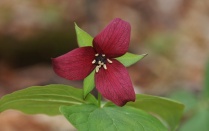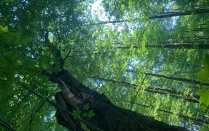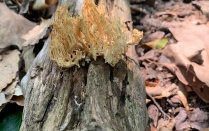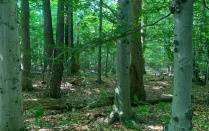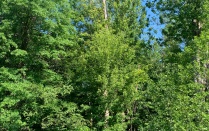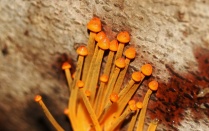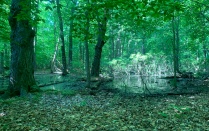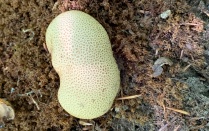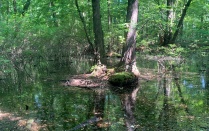Plants found in Letchworth Teaching Forest
While exploring the trail, take a moment to experience the ancient characteristics of an old growth forest. Once inside you will find an array of native tree and plant species in different stages of growth and decay. You will see some trees with an almost two foot diameter due to the age and preservation of these woods.
The most common trees here are Sugar Maples and Beech; some other varieties of Maples can be seen as well. There are also plenty of uncommon botanical species. Keep an eye out for Cucumber trees, Black Gum, Pin Oaks, and even Tulip trees. Walking by the side adjacent to Bizer Creek some visitors will also spot several species of Willow Trees but not many so you may have to look closely.
All photos shown below have been provided by our UB students. We encourage all other students to send us photos of their experiences on the trail to evs-admin@buffalo.edu. Your photo may even be added to our website!
Red Trillium (Trillium erectum) - April 2021 (Photo by Nikolai Harper)
These native spring ephemerals have distinctive three petal flowers and slightly foul odor make them easily identifiable.
Sugar Maple (Acer saccharum) - June 2021 (Photo by Sean Lepo)
The Sugar Maple Tree is a familiar sight for all northern states and these long living giants fill up our woods.
Coral fungus (Clavulina Cristata)- August 2021 (Photo by Sean Lepo)
Coral Fungus is another unique variety of fungus found within these woods, typically on decrepit logs or the ground. They have a peculiar shape and leave a white residue behind.
American Beech Trees (Fagus grandifolia)- July 2021 (Photo by Sean Lepo)
These tall slender trees can be easily spotted with their smooth grey trunks. They are the perfect match for living with Sugar Maple Trees.
Beech-Maple Climax state - July 2021 (Photo by Sean Lepo)
The Northeastern U.S. climax state of a closed canopy forest consists of these two trees predominantly, the perfect environment for spring ephemerals.
Orange Mycena (Mycena leaiana) - June 12 2020 (Photo by Nikolai Harper)
These bright orange fungi are predominantly found on decrepit logs and are most known for their pigment which has minor antibacterial activity, but we don't recommend eating them.
Tulip Poplar (Liriodendron tulipifera)- July 2021 (Photo by Sean Lepo)
The Tulip tree is one of the largest native to eastern North America and grows well in shaded areas. The sapling seen here will take less than 15 years to reach upwards of 40 feet tall and when full size can be close to 200 feet.
Vernal Pond - July 2021 (Photo by Sean Lepo)
Vernal ponds are common for Beech-Maple forest climax states. The ponds found in our woods are home to four species (and counting) of salamanders.
Puffball Mushroom (Scleroderma citrinum.) - July 2021 (Photo by Sean Lepo)
These species of fungi are commonly mistaken for truffles but don't be fooled, they will make you sick.
Vernal Pond #2- July 2021 (Photo by Sean Lepo)
These ponds, found along the trail, appear and recede yearly in accordance with the weather. The beauty and biodiversity they bring is something you don’t want to miss.
Shelf Fungus (Fomitopsis genus)- July 2021 (Photo by Sean Lepo)
Shelf fungi are known for their shape and function of consuming nutrients from dead trees. These fungi play a key role in the health of a forest ecosystem.
Fallen Tree - July 2021 (Photo by Sean Lepo)
Within The Letchworth Teaching Forest you will notice many fallen and decaying trees, similar to the one pictured. Take a closer look to see the numerous species of mosses, fungi, and insects now using them as a home.
